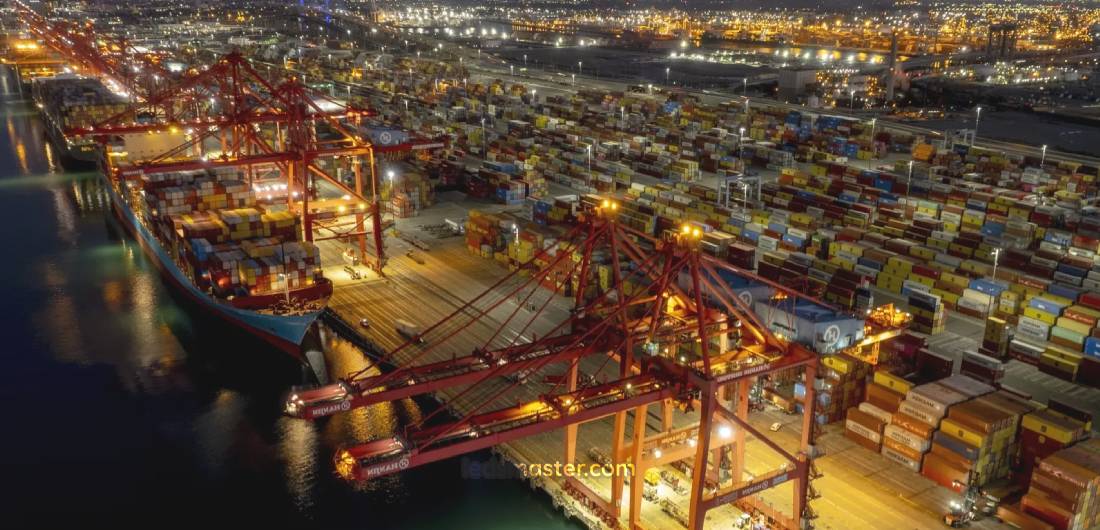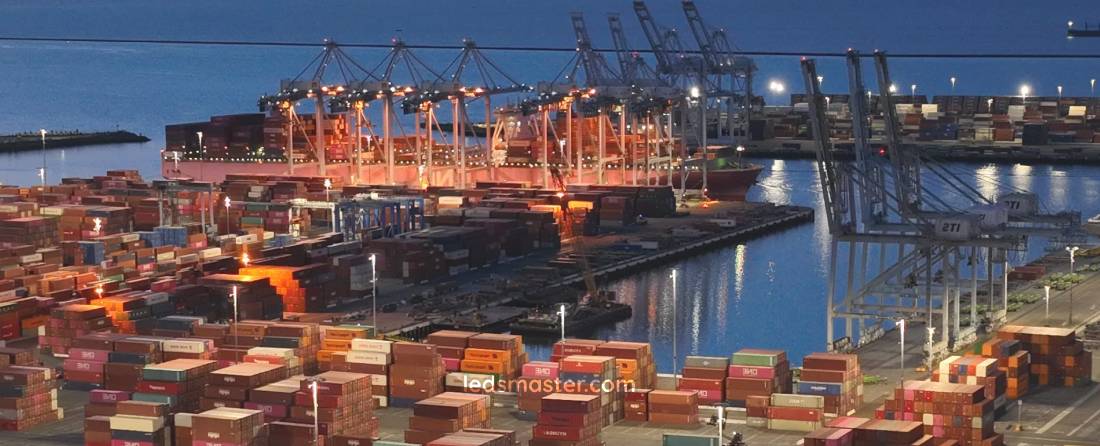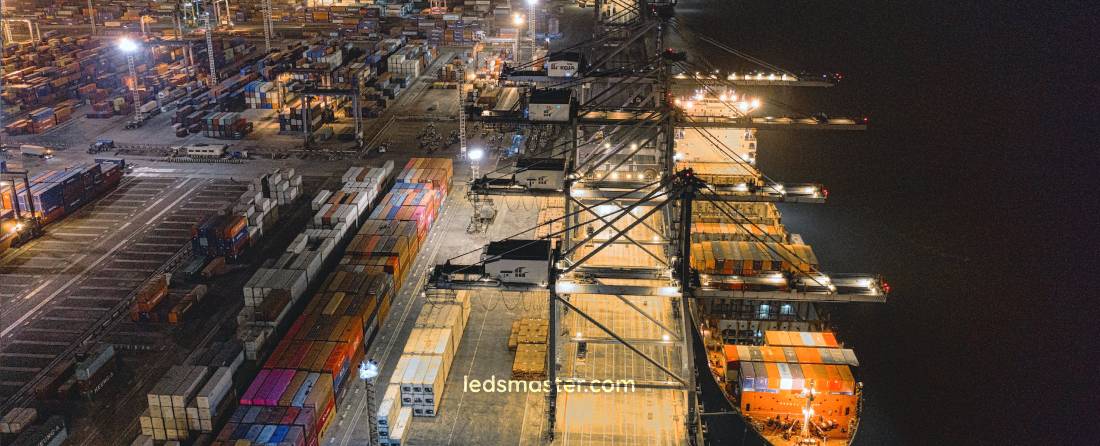Picture a container port bustling with activity as the sun sets, illuminated by a strategic mix of lighting that ensures safe and efficient operations. Understanding the different types of lighting available for these ports is key to optimizing visibility and managing costs.
Get your complimentary lighting design today
The cost of lighting at these ports is not just about the initial investment but also includes long-term operational and maintenance expenses. Understanding the various cost components associated with container port lighting can help port authorities and managers make informed decisions that balance performance, energy efficiency, and financial considerations.
The following table provides a range of estimated costs associated with container port lighting.
| Cost Component | High-Intensity Discharge (HID) Lights | Light Emitting Diodes (LEDs) | Fluorescent Lights |
|---|---|---|---|
| Initial Fixture Cost | $100 – $500 per fixture | $200 – $800 per fixture | $50 – $150 per fixture |
| Installation Labor Costs | $1,000 – $3,000 per installation | $1,500 – $5,000 per installation | $1,000 – $2,500 per installation |
| Infrastructure Modifications | $5,000 – $15,000 | $7,000 – $20,000 | $5,000 – $12,000 |
| Energy Consumption | 400 – 1,000 watts per fixture | 100 – 300 watts per fixture | 200 – 500 watts per fixture |
| Utility Costs | $0.10 – $0.20 per kWh | $0.03 – $0.07 per kWh | $0.05 – $0.12 per kWh |
| Maintenance Frequency | Every 1 – 2 years | Every 5 – 10 years | Every 1 – 2 years |
| Replacement Costs | $100 – $500 per fixture | $200 – $400 per fixture | $50 – $150 per fixture |
| Operational Lifespan | 10,000 – 20,000 hours | 50,000 – 100,000 hours | 10,000 – 20,000 hours |
| Maintenance and Repair Costs | $200 – $500 per year | $50 – $150 per year | $200 – $400 per year |
| Compliance with Environmental Regulations | $1,000 – $5,000 | $500 – $2,000 | $1,000 – $3,000 |
| Potential Incentives/Rebates | Minimal to None | $500 – $2,000 | Minimal to None |
| Long-Term Cost Benefits | Moderate savings | Significant savings | Moderate savings |
Table of Contents
Toggle
High-Intensity Discharge (HID) lights, including metal halide and high-pressure sodium lamps, have been a traditional choice for container port lighting. They offer high luminosity and are well-suited for large areas. The initial cost of HID lights generally includes the price of the fixture and the associated installation expenses. While HID lights are less expensive to purchase compared to LEDs, their operational costs can be higher due to greater energy consumption and more frequent maintenance needs. The lamps have a shorter lifespan, which results in more frequent replacements and higher overall costs over time.
LED technology has revolutionized lighting in many sectors, including container ports. LEDs are known for their energy efficiency, long lifespan, and low maintenance requirements. Although the initial cost of LED lighting systems is higher than that of HID lights, the long-term benefits often outweigh the upfront investment. LEDs consume significantly less power, which reduces utility bills. They also have a longer operational life, which decreases the frequency of replacements and maintenance. The reduced energy consumption and lower maintenance needs contribute to substantial cost savings over the life of the lighting system.
Fluorescent lighting, though less common in modern container ports, still sees some use. They are generally cheaper than LEDs but more expensive to operate compared to LEDs. Fluorescent lights have a moderate lifespan and efficiency but are less durable and more prone to failure in harsh environments. Their maintenance costs can be higher than LEDs due to the need for frequent replacements and repairs.

The cost of purchasing lighting fixtures is a major component of the initial investment in container port lighting. HID lights typically have a lower purchase cost compared to LEDs. However, the total cost includes not just the fixtures themselves but also the ancillary components such as mounting hardware and control systems. For LED lights, the higher upfront cost reflects their advanced technology and energy efficiency.
Installation labor represents a significant portion of the initial expense. Installing lighting fixtures in a container port involves considerable labor, including the setup of poles, wiring, and control systems. The complexity of the installation process can vary based on the type of lighting and the existing infrastructure. While LEDs often require more specialized installation due to their advanced technology, their longer lifespan can lead to lower maintenance labor costs in the future.
Modifications to existing infrastructure, such as adding or upgrading poles, wiring, and control systems, are necessary to accommodate new lighting. These modifications can be substantial, particularly if the current setup is outdated or inadequate for the new lighting technology. The costs associated with these changes can vary significantly depending on the extent of the modifications required and the condition of the existing infrastructure.
Energy consumption is a major factor in the ongoing cost of lighting. HID lights typically consume more power than LEDs, leading to higher utility bills. LEDs, on the other hand, offer significant savings in energy consumption due to their efficiency. Over time, these savings can offset the higher initial cost of LED fixtures and contribute to lower overall operational costs.
Maintenance costs include both routine upkeep and emergency repairs. HID lights require more frequent maintenance and repairs due to their shorter lifespan and higher failure rates. This can include costs for labor and replacement parts. LEDs, with their longer lifespan and durability, generally incur lower maintenance costs. Their design also often includes features that reduce the need for frequent repairs, further contributing to cost savings.
The cost of replacing lighting fixtures varies depending on the type of light used. HID lights need to be replaced more often than LEDs, leading to higher long-term costs. The replacement of fluorescent lights can also be relatively frequent and costly compared to LEDs. The lower frequency of replacements required for LEDs contributes to their cost-effectiveness over the long term.

LED lighting offers significant long-term cost benefits primarily due to its energy efficiency. LEDs consume less power while providing the same or greater levels of illumination compared to traditional lighting options like HID and fluorescent lights. This reduced energy consumption translates into lower utility bills. Additionally, the extended lifespan of LEDs means fewer replacements and less frequent maintenance, further reducing costs.
The durability of lighting fixtures affects their overall cost-effectiveness. LEDs are designed to withstand harsh conditions and have a longer lifespan than HID and fluorescent lights. This durability reduces the need for frequent replacements and repairs, translating into lower maintenance costs and fewer interruptions in lighting performance. The extended lifespan of LEDs means that the initial investment is spread out over a longer period, enhancing the return on investment.
Reduced maintenance frequency is a significant advantage of LED lighting. With fewer components subject to wear and tear, LEDs require less frequent servicing and repairs compared to HID and fluorescent lights. This not only reduces labor costs but also minimizes downtime and disruption at the container port. The long-term savings associated with reduced maintenance contribute to the overall cost-effectiveness of LED lighting.
Container ports are subject to various environmental regulations, including those related to light pollution and energy efficiency. Compliance with these regulations can entail additional costs, such as installing lighting systems that minimize light spill and glare. However, investing in energy-efficient lighting solutions like LEDs can help ports meet these requirements while also benefiting from lower operational costs.
Many regions offer incentives or rebates for the adoption of energy-efficient lighting technologies. These financial incentives can help offset the higher initial cost of LED lighting systems. Ports that invest in energy-efficient lighting may benefit from reduced upfront expenses and ongoing savings through lower utility bills. Exploring available incentives can provide additional cost benefits and support the transition to more sustainable lighting solutions.
| Lighting Option | Initial Cost | Energy Consumption (kWh/year) | Maintenance Costs (per year) | Lifespan | Total Cost Over Lifespan | Estimated Annual Savings | Impact on Operational Efficiency | Impact on Safety |
|---|---|---|---|---|---|---|---|---|
| LED | $100,000 | 250,000 | $5,000 | 10 years | $175,000 | $50,000 | Significant improvement in visibility and performance | Reduces accidents and enhances safety |
| HID | $60,000 | 500,000 | $10,000 | 5 years | $140,000 | $20,000 | Moderate improvement in visibility and performance | Moderate reduction in accidents |
| Fluorescent | $30,000 | 700,000 | $15,000 | 3 years | $130,000 | $5,000 | Minimal improvement in visibility and performance | Minimal reduction in accidents |
Calculating the return on investment involves comparing the total costs associated with different lighting options over their respective lifespans. For instance, while LEDs have a higher initial cost, their lower energy consumption and maintenance costs typically result in greater savings over time compared to HID and fluorescent lights. Performing a detailed ROI analysis helps port authorities and managers evaluate the long-term financial benefits of investing in more expensive but efficient lighting technologies.
Lighting plays a crucial role in operational efficiency and safety at container ports. Better lighting improves visibility, reduces accidents, and enhances overall operational performance. Investing in high-quality, efficient lighting solutions not only reduces costs but also contributes to a safer and more efficient working environment. Evaluating the impact of lighting improvements on operational efficiency and safety can further justify the investment in advanced lighting technologies.
The following table provides a range of estimated costs associated with container port lighting.
Evaluating the cost of container port lighting involves a comprehensive analysis of initial installation expenses, operational and maintenance costs, and long-term benefits. By considering factors such as energy efficiency, durability, and regulatory requirements, port authorities can make informed decisions that balance cost and performance. Investing in advanced lighting technologies like LEDs can offer substantial long-term savings and improvements in operational efficiency and safety.